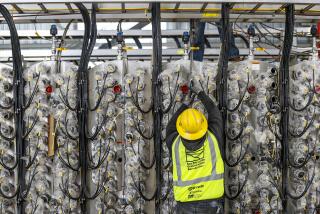The Greening of a Superfund Site
FULLERTON — Four years ago, Rick Murphy moved into a quiet hillside neighborhood with just one drawback: a Superfund site with a dozen pits of petroleum sludge just over his back fence.
It gave off a “rotting odor,” Murphy said, a “heavy, thick, oily, sludgy kind of smell.”
But last spring, the air began to sweeten. Now Murphy and his neighbors literally are breathing easier.
The toxic mess known as the McColl site, which the federal government declared a high priority shortly after the Superfund cleanup law was enacted in 1980, has at last been boxed and sealed.
Fumes arising from what was a World War II-era oil refinery waste dump--once operated by a man named Eli McColl--are now drawn through pipes and scrubbed by carbon filters. A cap of high-density polyethylene laid atop the pits keeps water out and cancer-causing chemicals in. Clay walls inserted as deep as 40 feet into the ground surround an estimated 100,000 cubic yards of such hazardous waste as sulfuric acid and benzene.
Today, public officials and representatives from oil companies that paid for the cleanup will proclaim the “waste containment system” finished and detail plans for a golf course to open next spring. The officials acknowledge that it is people such as Murphy, living on the curving, tree-lined streets of northwest Fullerton, who have the most to celebrate as work on the Superfund site winds down.
“Living next to it has not been pleasant, and life has been tough at times,” Rep. Ed Royce (R-Fullerton) said in a prepared statement. “They’ve gone through study after study and meeting after meeting. The community has been through a lot.”
Gone, for the most part, are the acrimony and uncertainty that have surrounded the fate of the 22-acre site at West Rosecrans Avenue and Sunny Ridge Drive, just east of Buena Park. There were lawsuits, since settled, by neighbors who complained of headaches, nausea and respiratory ailments. There were plans, since scuttled, to haul away the waste or neutralize it by injecting a cement-like substance into the ground.
But once the cap-and-golf plan was reached, work proceeded quickly after groundbreaking in August 1996.
Randy Wittorp, a spokesman for the U.S. Environmental Protection Agency, said Thursday that figures were unavailable on how much public money has been spent on the site since it was put on the Superfund list in September 1983.
Al Hendricker, an oil company representative, said Shell Oil Co., Arco, Texaco Inc., Union Oil Co. of California and Phillips Petroleum Co. have paid an estimated $80 million total on studies, plans, construction and other costs over the years.
Neighbors praise the construction crews that the oil companies hired. Murphy, 54, a salesman who works out of his home, said the contractor replaced a section of his driveway and replastered his kitchen after vibrations from the construction caused cracks. Other neighbors spent a few months in hotel rooms--free of charge--to escape the racket.
“The smell was horrible, but all the odors are gone,” Murphy said. “We’re thrilled to see it end.”
Earlier this week, construction crews could be seen working behind the black wrought-iron bars that have replaced a chain-link fence.
They were lining the bottom of what will be a lake on a nine-hole golf course, to be fed by a new storm drain system. Backhoes were grading future sand traps and putting greens. A lattice of exposed irrigation pipes awaited new grass.
The most important work lay underground. Patti Collins, an environmental scientist for the EPA, called the waste containment system “state of the art.”
The multilayered cap includes 17,000 tons of cobbled rock, 452,000 square feet of textiled cushioning, 287,000 square feet of a synthetic clay liner, 410,000 square feet of high-density plastic, 9,800 feet of gas collection pipes and 40,000 tons of sand.
That’s not counting the clay walls encircling the pits, to prevent downhill seepage of the underground chemicals, and 24 gas monitoring probes.
Though the project was engineered in great detail, Collins said contractors confronted many variables along the way. There were the winter rains, the summer heat and the unpredictability of dealing with chemicals buried deep underground half a century ago.
“Everything that happens at a project like this is unusual,” Collins said. “It requires an amazing amount of teamwork. You have to be on top of it every minute and address every new thing you find. It isn’t like building a bridge, that’s for sure.”
By spring, Collins said, nearly all traces of the Superfund cleanup will vanish. “No one will see anything that looks like anything other than a beautifully landscaped golf course,” she said.
More to Read
Sign up for Essential California
The most important California stories and recommendations in your inbox every morning.
You may occasionally receive promotional content from the Los Angeles Times.









